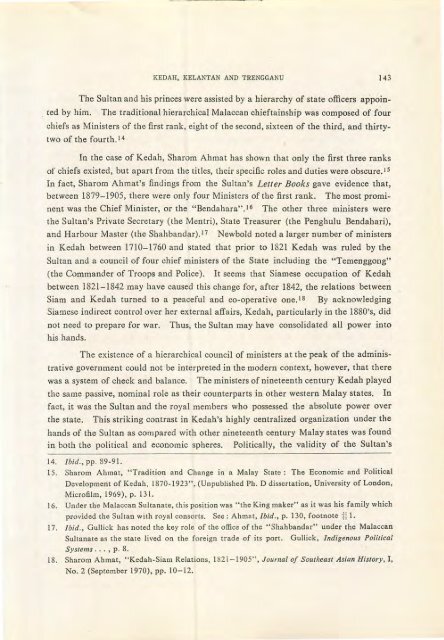The Journal of the Siam Society Vol. LXXII, Part 1-2, 1984 - Khamkoo
The Journal of the Siam Society Vol. LXXII, Part 1-2, 1984 - Khamkoo
The Journal of the Siam Society Vol. LXXII, Part 1-2, 1984 - Khamkoo
You also want an ePaper? Increase the reach of your titles
YUMPU automatically turns print PDFs into web optimized ePapers that Google loves.
KEDAR, KELANTAN AND TRENGGANU 143<br />
<strong>The</strong> Sultan and his princes were assisted by a hierarchy <strong>of</strong> state <strong>of</strong>ficers appom<br />
. ted by him. <strong>The</strong> traditional hierarchical Malaccan chieftainship was composed <strong>of</strong> four<br />
chiefs as Ministers <strong>of</strong> <strong>the</strong> first rank, eight <strong>of</strong> 1he second, sixteen <strong>of</strong> <strong>the</strong> third, and thirtytwo<br />
<strong>of</strong> <strong>the</strong> fourth.l4<br />
In <strong>the</strong> case <strong>of</strong> Kedah, Sharom Ahmat has shown that only <strong>the</strong> first three ranks<br />
<strong>of</strong> chiefs existed, but apart from <strong>the</strong> titles, <strong>the</strong>ir specific roles and duties were obscure. IS<br />
In fact, Sharom Ahmat's findings from <strong>the</strong> Sultan's Letter Books gave evidence that,<br />
between 1879-1905, <strong>the</strong>re were only four Ministers <strong>of</strong> <strong>the</strong> first rank. <strong>The</strong> most prominent<br />
was <strong>the</strong> Chief Minister, or <strong>the</strong> "Bendahara''.l 6<br />
<strong>The</strong> o<strong>the</strong>r three ministers were<br />
<strong>the</strong> Sultan's Private Secretary (<strong>the</strong> Mentri), State Treasurer (<strong>the</strong> Penghulu Bendahari),<br />
and Harbour Master (<strong>the</strong> Shahbandar).l 7<br />
Newbold noted a larger number <strong>of</strong> ministers<br />
in Kedah between 1710-1760 and stated that prior to 1821 Kedah was ruled by <strong>the</strong><br />
Sultan and a council <strong>of</strong> four chief ministers <strong>of</strong> <strong>the</strong> State including <strong>the</strong> "Temenggong"<br />
(<strong>the</strong> Commander <strong>of</strong> Troops and Police).<br />
It seems that <strong>Siam</strong>ese occupation <strong>of</strong> Kedah<br />
between 1821-1842 may have caused this change for, after 1842, <strong>the</strong> relations between<br />
<strong>Siam</strong> and Kedah turned to a peaceful and co-operative one.IB By acknowledging<br />
<strong>Siam</strong>ese indirect control over her external affairs, Kedah, particularly in <strong>the</strong> 1880's, did<br />
not need to prepare for war.<br />
his hands.<br />
Thus, <strong>the</strong> Sultan may have consolidated all power into<br />
<strong>The</strong> existence <strong>of</strong> a hierarchical council <strong>of</strong> ministers at <strong>the</strong> peak <strong>of</strong> <strong>the</strong> administrative<br />
government could not be interpreted in <strong>the</strong> modern context, however, that <strong>the</strong>re<br />
was a system <strong>of</strong> check and balance.<br />
<strong>The</strong> ministers <strong>of</strong> nineteenth century Kedah played<br />
<strong>the</strong> same passive, nominal role as <strong>the</strong>ir counterparts in o<strong>the</strong>r western Malay states.<br />
fact, it was <strong>the</strong> Sultan and <strong>the</strong> royal members who possessed <strong>the</strong> absolute power over<br />
<strong>the</strong> state.<br />
This striking contrast in Kedah's highly centralized organization under <strong>the</strong><br />
bands <strong>of</strong> <strong>the</strong> Sultan as compared with o<strong>the</strong>r nineteenth century Malay states was found<br />
in both <strong>the</strong> political and economic spheres. Politically, <strong>the</strong> validity <strong>of</strong> <strong>the</strong> Sultan's<br />
14. Ibid., pp. 89-91.<br />
15. Sharom Ahmat, "Tradition and Change in a Malay State: <strong>The</strong> Economic and Political<br />
Development <strong>of</strong> Kedah, 1870- 1923 ", (Unpublished Ph. D dissertation, University <strong>of</strong> London,<br />
Micr<strong>of</strong>ilm, 1969), p. 131.<br />
!6. Under <strong>the</strong> Malaccan Sultanate, this position was "<strong>the</strong> King maker" as it was his family which<br />
provided <strong>the</strong> Sultan with royal consorts. See: Ahmat, Ibid., p. 130, footnote ~ · ! 1.<br />
17. Ibid., Gullick has noted <strong>the</strong> key role <strong>of</strong> <strong>the</strong> <strong>of</strong>fice <strong>of</strong> <strong>the</strong> "Shahbandar" under <strong>the</strong> Malaccan<br />
Sultanate as <strong>the</strong> state lived on <strong>the</strong> foreign trade <strong>of</strong> its port. Gullick, Indigenous Political<br />
Systems .. . , p. 8.<br />
18. Sharom Ahmat, "Kedah-<strong>Siam</strong> Relations, 1821 -1905", <strong>Journal</strong> <strong>of</strong> Sou<strong>the</strong>ast Asian History, I,<br />
No.2 (September 1970), pp. 10-12.<br />
In

















